tow TOYOTA PRIUS PRIME 2022 User Guide
[x] Cancel search | Manufacturer: TOYOTA, Model Year: 2022, Model line: PRIUS PRIME, Model: TOYOTA PRIUS PRIME 2022Pages: 808, PDF Size: 14.72 MB
Page 223 of 808
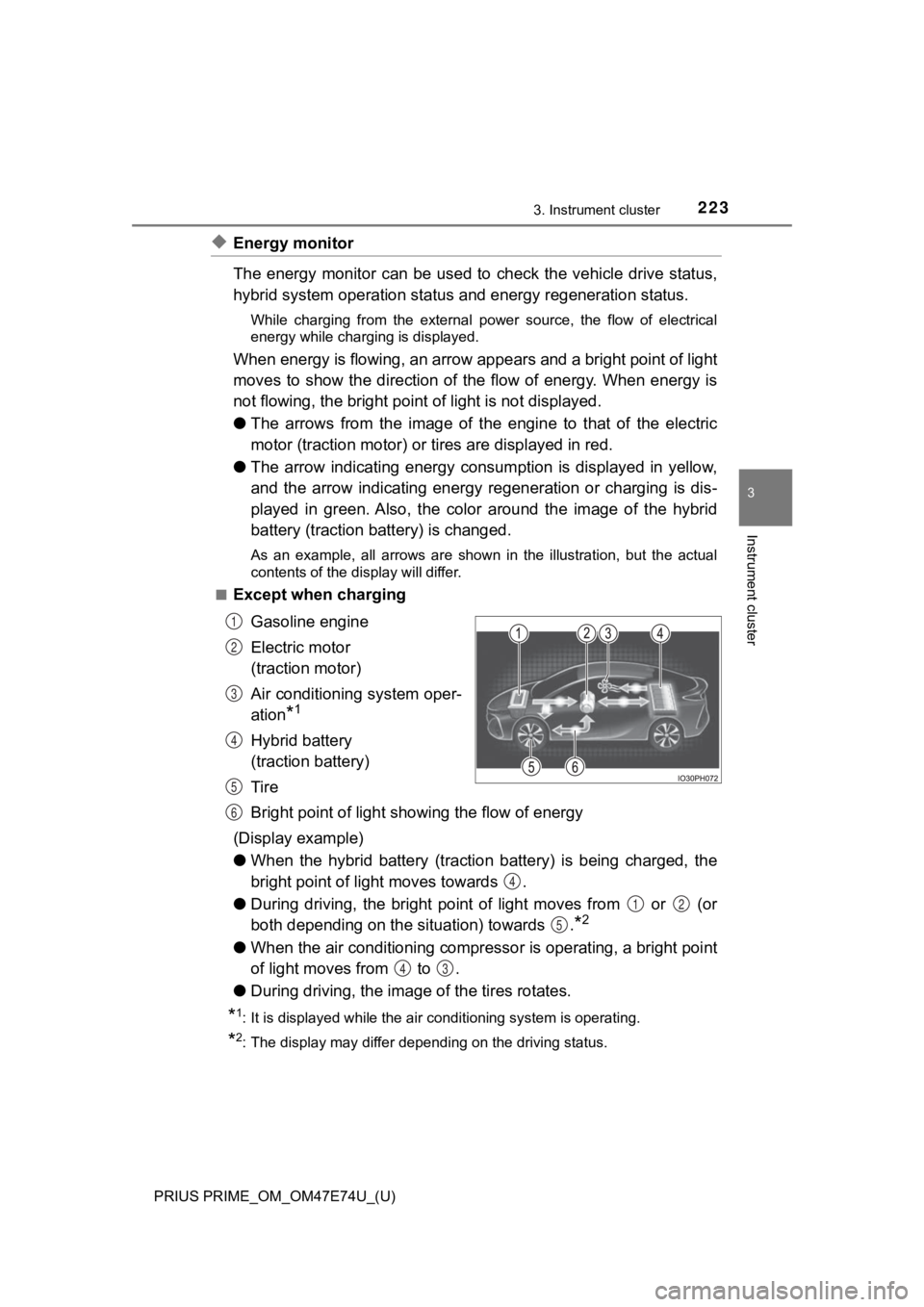
PRIUS PRIME_OM_OM47E74U_(U)
2233. Instrument cluster
3
Instrument cluster
◆Energy monitor
The energy monitor can be used to check the vehicle drive status,
hybrid system operation status and energy regeneration status.
While charging from the external power source, the flow of electrical
energy while charging is displayed.
When energy is flowing, an arrow appears and a bright point of light
moves to show the direction of the flow of energy. When energy is
not flowing, the bright point of light is not displayed.
● The arrows from the image of the engine to that of the electric
motor (traction motor) or ti res are displayed in red.
● The arrow indicating energy consumption is displayed in yellow,
and the arrow indicating energy regeneration or charging is dis -
played in green. Also, the color around the image of the hybrid
battery (traction battery) is changed.
As an example, all arrows are shown in the illustration, but th e actual
contents of the display will differ.
■
Except when charging
Gasoline engine
Electric motor
(traction motor)
Air conditioning system oper-
ation
*1
Hybrid battery
(traction battery)
Tire
Bright point of light showing the flow of energy
(Display example)
● When the hybrid battery (traction battery) is being charged, th e
bright point of li ght moves towards .
● During driving, the bright point of light moves from or (or
both depending on the s ituation) towards .
*2
●When the air conditioning compres sor is operating, a bright point
of light moves from to .
● During driving, the image of the tires rotates.
*1: It is displayed while the air c onditioning system is operating .
*2: The display may differ depending on the driving status.
1
2
3
4
5
6
4
12
5
43
Page 233 of 808
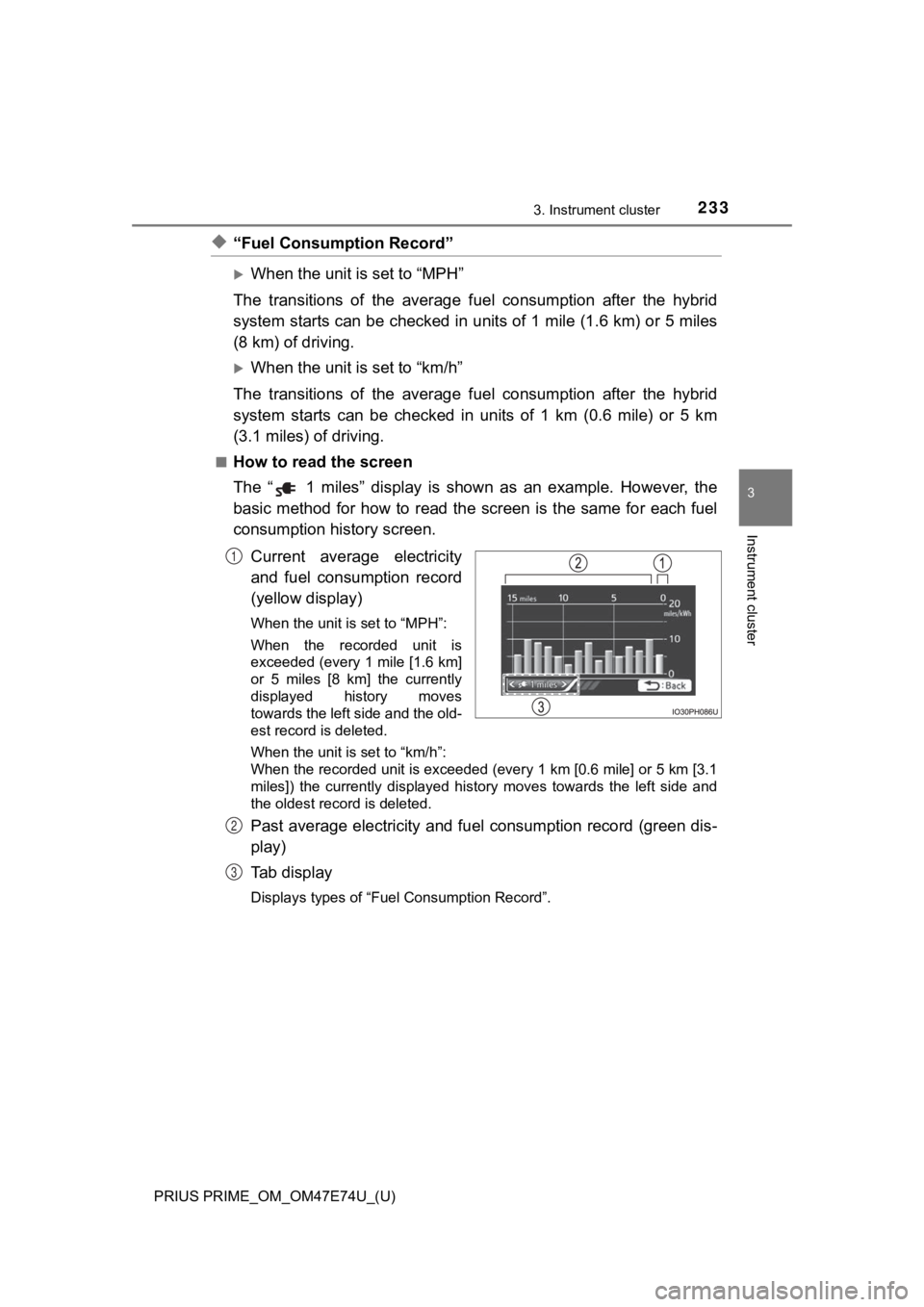
PRIUS PRIME_OM_OM47E74U_(U)
2333. Instrument cluster
3
Instrument cluster
◆“Fuel Consumption Record”
When the unit is set to “MPH”
The transitions of the average fu el consumption after the hybrid
system starts can be checked in units of 1 mile (1.6 km) or 5 m iles
(8 km) of driving.
When the unit is set to “km/h”
The transitions of the average fu el consumption after the hybrid
system starts can be checked in units of 1 km (0.6 mile) or 5 k m
(3.1 miles) of driving.
■How to read the screen
The “ 1 miles” display is shown as an example. However, the
basic method for how to read the screen is the same for each fu el
consumption hi story screen.
Current average electricity
and fuel consumption record
(yellow display)
When the unit is set to “MPH”:
When the recorded unit is
exceeded (every 1 mile [1.6 km]
or 5 miles [8 km] the currently
displayed history moves
towards the left side and the old-
est record is deleted.
When the unit is set to “km/h”:
When the recorded unit is exceeded (every 1 km [0.6 mile] or 5 km [3.1
miles]) the currently displayed history moves towards the left side and
the oldest record is deleted.
Past average electricity and fuel consumption record (green dis -
play)
Tab display
Displays types of “Fuel Consumption Record”.
1
2
3
Page 293 of 808

PRIUS PRIME_OM_OM47E74U_(U)
2934-2. Opening, closing and locking the doors
4
Operation of each component
■Conditions affecting operation
The smart key system, wireless remote control and immobilizer s ystem use
weak radio waves. In the following situations, the communication between
the electronic key and the vehicle may be affected, preventing the smart key
system, wireless remote control and immobilizer system from operating prop-
erly. (Ways of coping: P. 708)
● When the electronic key battery is depleted
● Near a TV tower, electric power plant, gas station, radio stati on, large dis-
play, airport or other facility that generates strong radio wav es or electrical
noise
● When the electronic key is in contact with, or is covered by the following
metallic objects
• Cards to which aluminum foil is attached
• Cigarette boxes that have aluminum foil inside
• Metallic wallets or bags
• Coins
• Hand warmers made of metal
• Media such as CDs and DVDs
● When other wireless key (that emit radio waves) is being used n earby
● When carrying the electronic key together with the following devices that
emit radio waves
• Portable radio, cellular phone, cordless phone or other wirele ss commu-
nication devices
• Another vehicle’s electronic key or a wireless key that emits radio waves
• Personal computers or personal digital assistants (PDAs)
• Digital audio players
• Portable game systems
● If window tint with a metallic content or metallic objects are attached to the
rear window
● When the electronic key is placed near a battery charger or ele ctronic
devices
Page 298 of 808
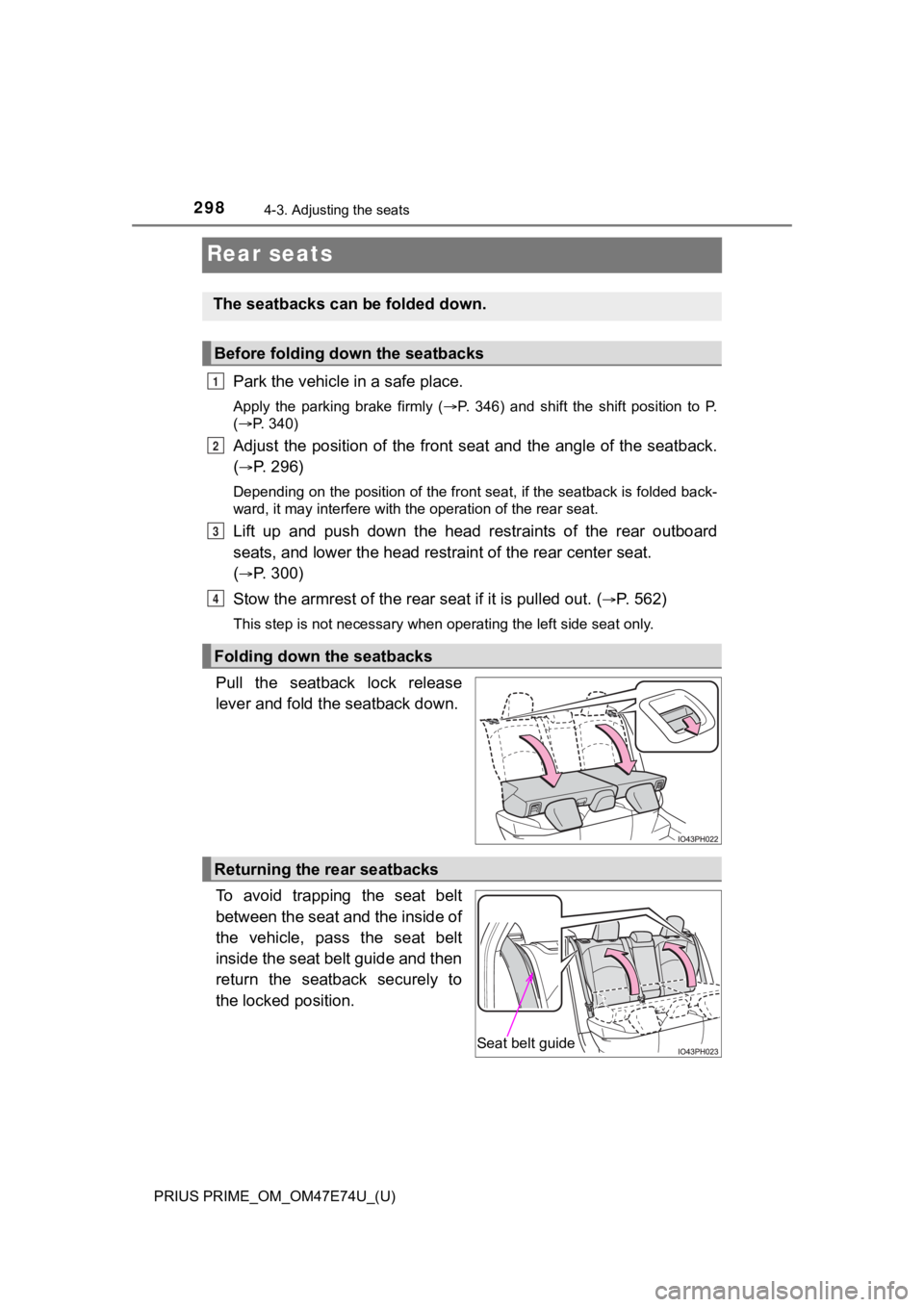
298
PRIUS PRIME_OM_OM47E74U_(U)
4-3. Adjusting the seats
Rear seats
Park the vehicle in a safe place.
Apply the parking brake firmly ( P. 346) and shift the shift position to P.
( P. 340)
Adjust the position of the front seat and the angle of the seatback.
(
P. 2 9 6 )
Depending on the position of the front seat, if the seatback is folded back-
ward, it may interfere with the operation of the rear seat.
Lift up and push down the head restraints of the rear outboard
seats, and lower the head rest raint of the rear center seat.
(
P. 3 0 0 )
Stow the armrest of the rear seat if it is pulled out. (
P. 562)
This step is not necessary when operating the left side seat on ly.
Pull the seatback lock release
lever and fold the seatback down.
To avoid trapping the seat belt
between the seat and the inside of
the vehicle, pass the seat belt
inside the seat belt guide and then
return the seatback securely to
the locked position.
The seatbacks can be folded down.
Before folding down the seatbacks
Folding down the seatbacks
1
2
3
4
Returning the rear seatbacks
Seat belt guide
Page 302 of 808
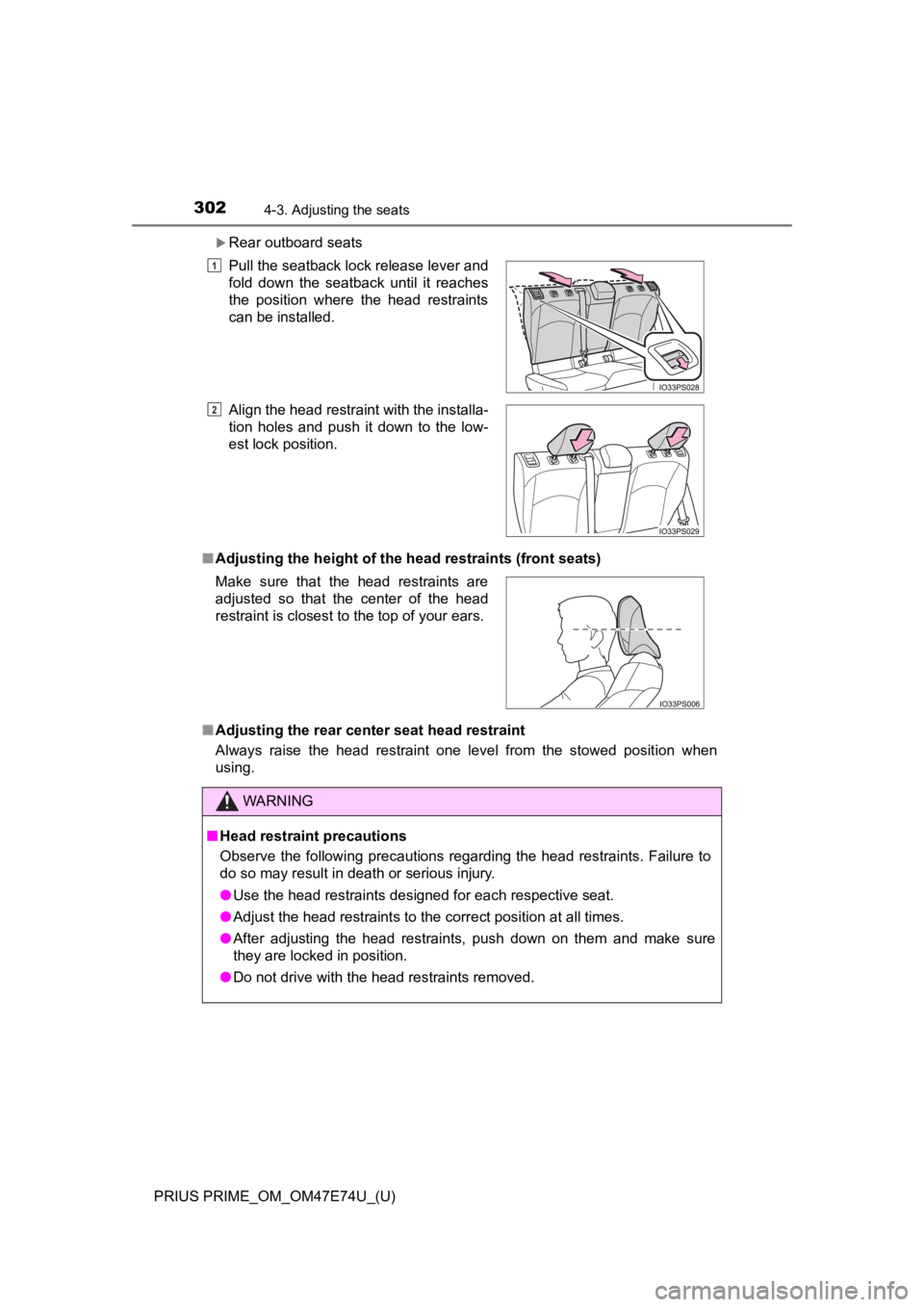
302
PRIUS PRIME_OM_OM47E74U_(U)
4-3. Adjusting the seats
Rear outboard seats
■ Adjusting the height of the head restraints (front seats)
■ Adjusting the rear center seat head restraint
Always raise the head restraint one level from the stowed position when
using.Pull the seatback lock release lever and
fold down the seatback until it reaches
the position where the head restraints
can be installed.
Align the head restraint with the installa-
tion holes and push it down to the low-
est lock position.
Make sure that the head restraints are
adjusted so that the center of the head
restraint is closest to the top of your ears.
WARNING
■ Head restraint precautions
Observe the following precautions regarding the head restraints. Failure to
do so may result in death or serious injury.
● Use the head restraints designed for each respective seat.
● Adjust the head restraints to the correct position at all times.
● After adjusting the head restraints, push down on them and make sure
they are locked in position.
● Do not drive with the head restraints removed.
1
2
Page 313 of 808
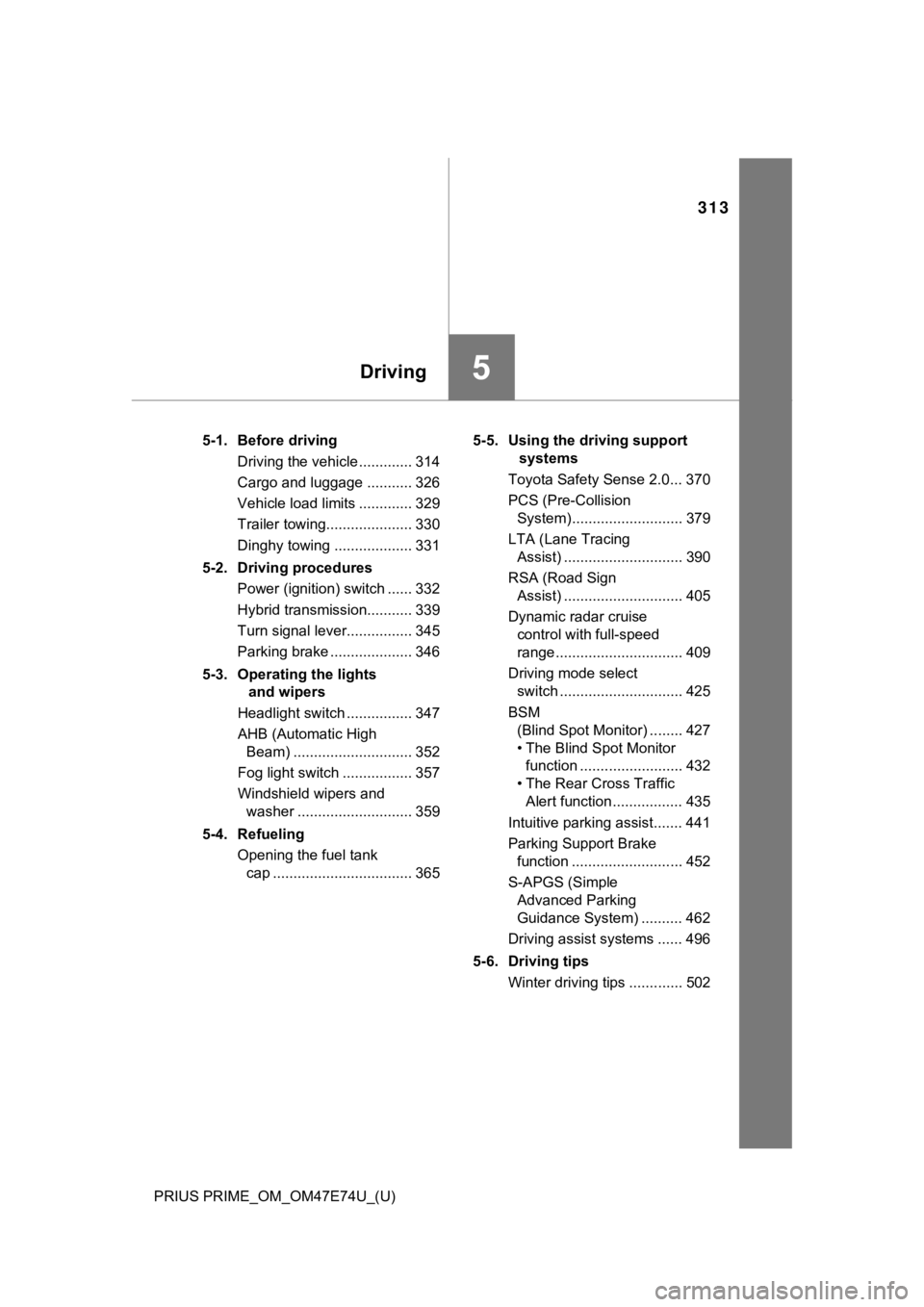
313
PRIUS PRIME_OM_OM47E74U_(U)
5Driving
5-1. Before drivingDriving the vehicle ............. 314
Cargo and luggage ........... 326
Vehicle load limits ............. 329
Trailer towing..................... 330
Dinghy towing ................... 331
5-2. Driving procedures Power (ignition) switch ...... 332
Hybrid transmission........... 339
Turn signal lever................ 345
Parking brake .................... 346
5-3. Operating the lights and wipers
Headlight switch ................ 347
AHB (Automatic High Beam) ............................. 352
Fog light switch ................. 357
Windshield wipers and washer ............................ 359
5-4. Refueling Opening the fuel tank cap .................................. 365 5-5. Using the driving support
systems
Toyota Safety Sense 2.0... 370
PCS (Pre-Collision System)........................... 379
LTA (Lane Tracing Assist) ............................. 390
RSA (Road Sign Assist) ............................. 405
Dynamic radar cruise control with full-speed
range............................... 409
Driving mode select switch .............................. 425
BSM (Blind Spot Monitor) ........ 427
• The Blind Spot Monitor function ......................... 432
• The Rear Cross Traffic Alert function ................. 435
Intuitive parking assist....... 441
Parking Support Brake function ........................... 452
S-APGS (Simple Advanced Parking
Guidance System) .......... 462
Driving assist systems ...... 496
5-6. Driving tips Winter driving tips ............. 502
Page 325 of 808
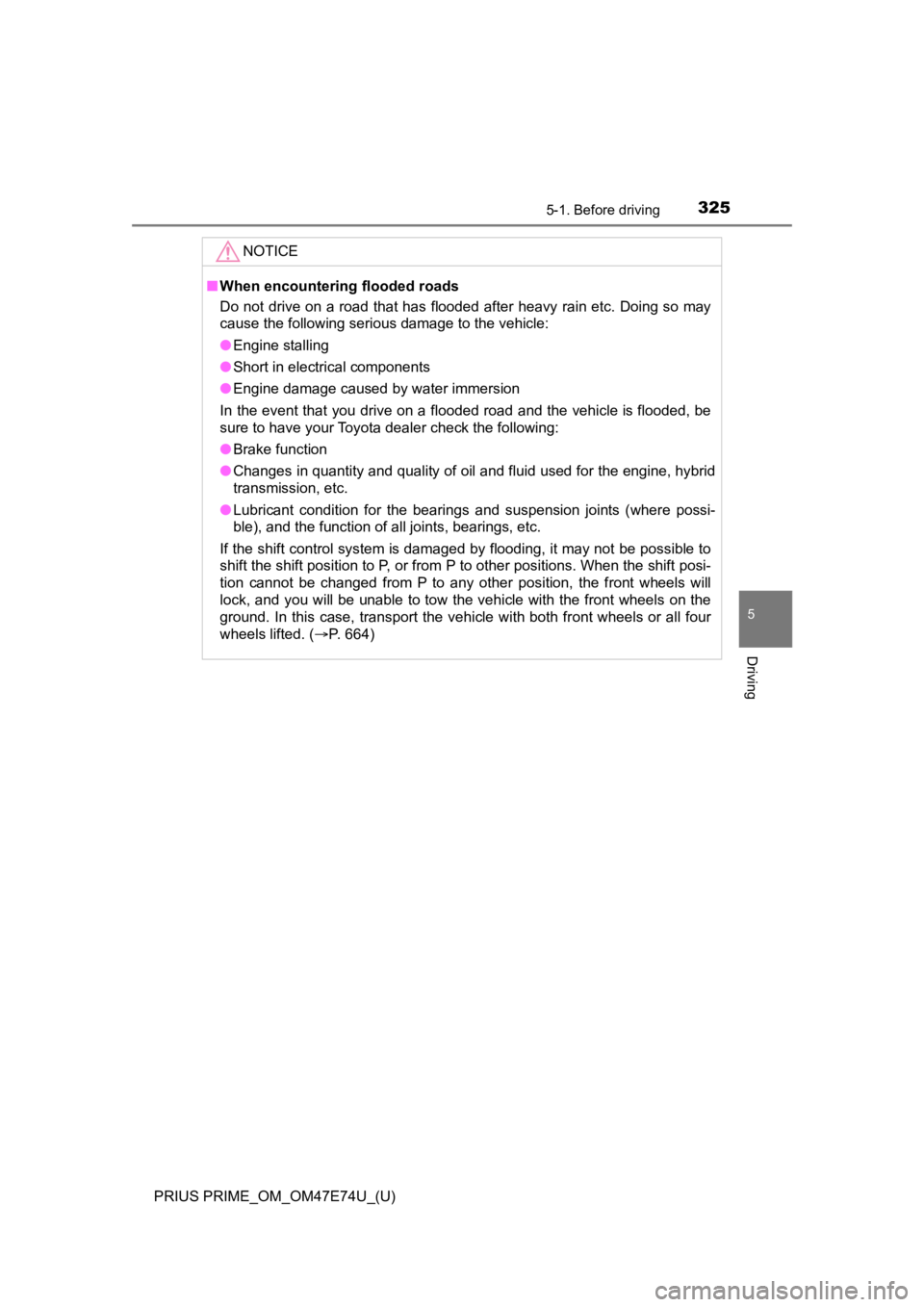
PRIUS PRIME_OM_OM47E74U_(U)
3255-1. Before driving
5
Driving
NOTICE
■When encountering flooded roads
Do not drive on a road that has flooded after heavy rain etc. D oing so may
cause the following serious damage to the vehicle:
● Engine stalling
● Short in electrical components
● Engine damage caused by water immersion
In the event that you drive on a flooded road and the vehicle i s flooded, be
sure to have your Toyota dealer check the following:
● Brake function
● Changes in quantity and quality of oil and fluid used for the engine, hybrid
transmission, etc.
● Lubricant condition for the bearings and suspension joints (where possi-
ble), and the function of all joints, bearings, etc.
If the shift control system is damaged by flooding, it may not be possible to
shift the shift position to P, or from P to other positions. When the shift posi-
tion cannot be changed from P to any other position, the front wheels will
lock, and you will be unable to tow the vehicle with the front wheels on the
ground. In this case, transport the vehicle with both front wheels or all four
wheels lifted. ( P. 664)
Page 326 of 808
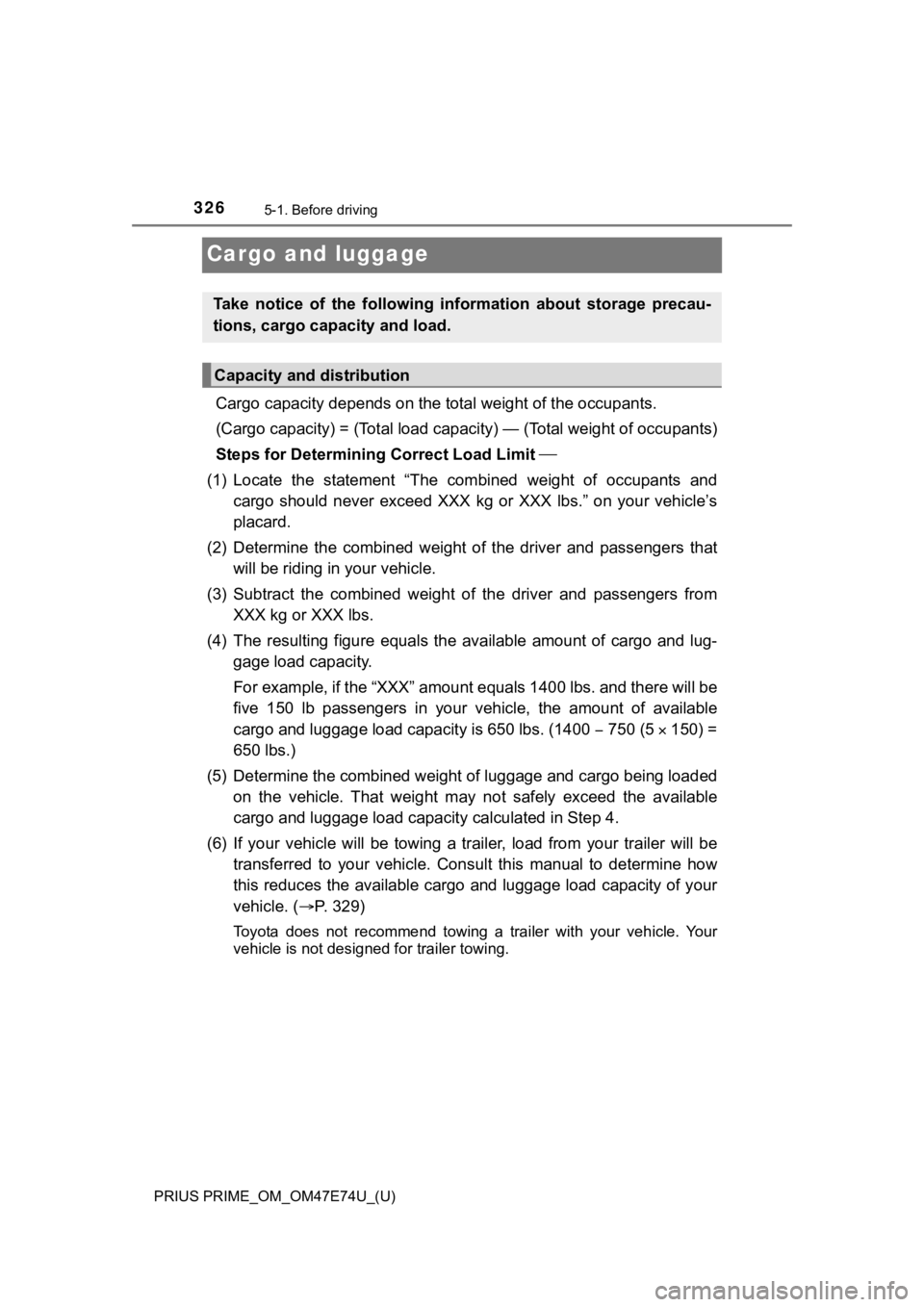
326
PRIUS PRIME_OM_OM47E74U_(U)
5-1. Before driving
Cargo and luggage
Cargo capacity depends on the total weight of the occupants.
(Cargo capacity) = (Total load capacity) — (Total weight of occ upants)
Steps for Determini ng Correct Load Limit
(1) Locate the statement “The co mbined weight of occupants and
cargo should never exceed XXX kg or XXX lbs.” on your vehicle’s
placard.
(2) Determine the combined weight of the driver and passengers t hat
will be riding in your vehicle.
(3) Subtract the combined weight of the driver and passengers fr om
XXX kg or XXX lbs.
(4) The resulting figure equals the available amount of cargo an d lug-
gage load capacity.
For example, if the “XXX” amount equals 1400 lbs. and there wil l be
five 150 lb passengers in your vehicle, the amount of available
cargo and luggage load capacity is 650 lbs. (1400 750 (5150) =
650 lbs.)
(5) Determine the combined weight of luggage and cargo being loa ded
on the vehicle. That weight may n ot safely exceed the available
cargo and luggage load capac ity calculated in Step 4.
(6) If your vehicle will be towing a trailer, load from your tra iler will be
transferred to your vehicle. Consult this manual to determine h ow
this reduces the available cargo and luggage load capacity of y our
vehicle. ( P. 329)
Toyota does not recommend towing a trailer with your vehicle. Y our
vehicle is not desig ned for trailer towing.
Take notice of the following information about storage precau-
tions, cargo capacity and load.
Capacity and distribution
Page 328 of 808

328
PRIUS PRIME_OM_OM47E74U_(U)
5-1. Before driving
WARNING
■Things that must not be carried in the luggage compartment
The following things may cause a fire if loaded in the luggage compart-
ment:
●Receptacles containing gasoline
●Aerosol cans
■Storage precautions
Observe the following precautions.
Failure to do so may prevent the pedals from being depressed pr operly,
may block the driver’s vision, or may result in items hitting t he driver or
passengers, possibly causing an accident.
●Stow cargo and luggage in the luggage compartment whenever poss i-
ble.
●Do not stack cargo and luggage in the luggage compartment highe r
than the seatbacks.
●When you fold down the rear seats, long items should not be pla ced
directly behind the front seats.
●Never allow anyone to ride in the luggage compartment. It is no t
designed for passengers. They should ride in their seats with their seat
belts properly fastened.
●Do not place cargo or luggage in or on the following locations.
• At the feet of the driver
• On the front passenger or rea r seats (when stacking items)
• On the luggage cover
• On the instrument panel
• On the dashboard
●Secure all items in the occupant compartment.
■Capacity and distribution
●Do not exceed the maximum axle weight rating or the total vehic le
weight rating.
●Even if the total load of occupant’s weight and the cargo load is less
than the total load capacity, do not apply the load unevenly. I mproper
loading may cause deterioration of steering or braking control which
may cause death or serious injury.
Page 329 of 808

329
PRIUS PRIME_OM_OM47E74U_(U)
5-1. Before driving
5
Driving
Vehicle load limits
◆Total load capacity (vehicle capacity weight): P. 726
Total load capacity means the co mbined weight of occupants, cargo
and luggage.
◆Seating capacity: P. 7 2 6
Seating capacity means the max imum number of occupants whose
estimated average weight is 150 lb. (68 kg) per person.
◆Towing capacity
Toyota does not recommend towi ng a trailer with your vehicle.
◆Cargo capacity
Cargo capacity may increase or decrease depending on the weight
and the number of occupants.
■Total load capacity and seating capacity
These details are also described on the tire and loading inform ation label.
( P. 620)
Vehicle load limits include total load capacity, seating capaci t y,
towing capacity and cargo capacity.
WARNING
■Overloading the vehicle
Do not overload the vehicle.
It may not only cause damage to the tires, but also degrade steering
and braking ability, res ulting in an accident.